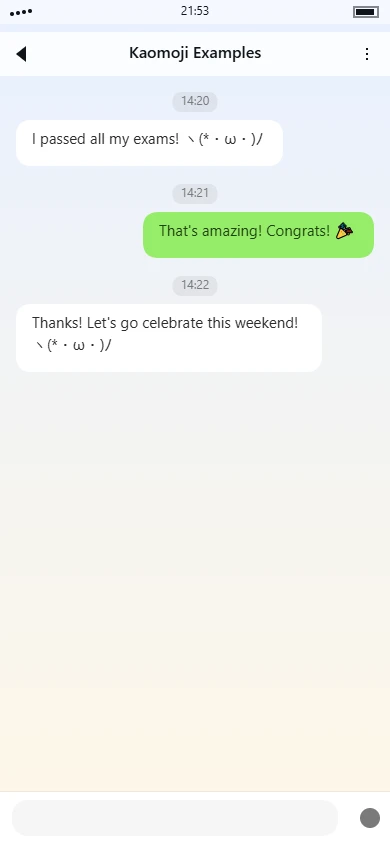(*¯︶¯*) kaomoji meaning | usage tips

Overview
This kaomoji (¯︶¯) presents a balanced facial expression with a distinct upward-curving mouth at its center. The overall structure uses parentheses as facial contours, creating a rounded face shape that frames the central smile element. The eyes are represented by asterisks positioned symmetrically on either side of the face, while the mouth consists of a macron character (¯) repeated on both sides of a low line character (︶) that forms the curved smile.
Symbol Breakdown
- Parentheses ( ): These symbols create the outer boundary of the face, giving it a rounded, friendly appearance while maintaining visual simplicity
- Asterisks (*): Positioned as eyes, these characters suggest a bright, attentive expression without being overly detailed
- Macron (¯): Used on both sides of the mouth, this horizontal line character provides stability to the facial structure
- Low line (︶): The central curved character forms the upward arc of the smile, creating the primary expression of contentment
- Symmetrical arrangement: The balanced placement of characters on both sides contributes to a harmonious visual effect
Emotion & Aesthetic Analysis
The kaomoji conveys a sense of gentle happiness or quiet contentment. The upward curve of the mouth suggests satisfaction rather than exuberant joy, making it suitable for situations where one wants to express mild pleasure or agreement. The symmetrical design and rounded facial contours create a visually balanced expression that appears calm and approachable.
Compared to more exaggerated smiling kaomoji like (^▽^) or (≧▽≦), this version maintains a more subdued tone. The absence of wide-open eyes or dramatic facial features makes it appropriate for casual conversations where a warm but not overwhelming positive response is desired. The character choices reflect a preference for clean lines and geometric shapes over more elaborate or cartoonish representations.
Tag categories
Use tags to quickly understand this kaomoji.
Style tags
Emotion tags
Expression tags
Object tags
Click tags to explore related kaomoji.
Usage guide
Usage Guide for (¯︶¯)
The (¯︶¯) kaomoji is one of those versatile digital expressions that perfectly captures a warm, contented smile with just a few characters. It's essentially a happy face with closed eyes and a gentle upward curve of the mouth, conveying feelings of satisfaction, peaceful happiness, or quiet pride. You'll often see this kaomoji used in casual online conversations where someone wants to express that they're feeling good about something without being overly excited or boastful. It carries a soft, gentle tone that makes it perfect for sharing small victories, expressing contentment, or simply showing that you're in a good mood. The closed eyes give it a slightly dreamy or blissful quality, making it ideal for moments of quiet satisfaction rather than loud celebration.
Common Use Cases
- When someone compliments your cooking and you want to humbly acknowledge it
- After finishing a difficult task at work and feeling relieved
- When a friend shares good news and you want to show genuine happiness for them
- In gaming chats after achieving a personal best score
- When sharing photos of a peaceful moment you're enjoying
- During casual group chats when someone tells a heartwarming story
- On social media posts about simple pleasures like a good cup of coffee
- When someone thanks you for help and you want to say "you're welcome" warmly
- In dating app conversations to show you're enjoying the chat
- When reminiscing about happy memories with friends
- After receiving a thoughtful message that makes you smile
- When discussing hobbies or interests you're passionate about
Example Conversations
-
Friend chat about weekend plans Person A: "Just booked tickets for that concert we wanted to see!" Person B: "No way! I've been waiting for this (¯︶¯)"
-
Workplace casual chat Colleague: "The client loved your presentation design" You: "Really? That's great to hear (¯︶¯)"
-
Social media comment Post: "Finally finished that novel I've been working on for months" Comment: "Congratulations! Can't wait to read it (¯︶¯)"
-
Family group chat Sibling: "Mom made your favorite cookies today" You: "Save some for me! (¯︶¯)"
-
Online gaming Teammate: "Nice shot! That was perfect timing" You: "Thanks! Got lucky there (¯︶¯)"
-
Dating app exchange Match: "I really enjoy our conversations" You: "Me too, you're really easy to talk to (¯︶¯)"
Important Notes
- Avoid using this kaomoji in formal business emails or serious professional discussions as it may come across as too casual or unprofessional
- Be mindful that the gentle, contented tone might be misinterpreted as passive-aggressive in certain contexts, especially during disagreements
- While generally positive, the closed eyes can sometimes be read as smug or self-satisfied if used in response to someone else's difficulties
This kaomoji works particularly well on platforms like Discord, Twitter, and casual messaging apps where the community appreciates nuanced emotional expression. Its popularity in Japanese online culture means it's widely recognized across international digital spaces, though the exact interpretation might vary slightly depending on the platform's predominant user base.
Usage examples
Real conversation samples that feature this kaomoji.

Example 1

Example 2
Related kaomoji
You might also enjoy these kaomoji.